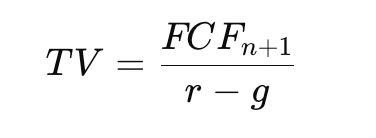Intrinsic Value and DCF – Tune Your DCF Model

Price is what you pay. Value is what you get.
- Warren Buffett
For many retail investors, the stock market feels like a game of speculation. Prices fluctuate daily, influenced by emotions, trends, and macroeconomic events. But seasoned investors like Buffett, Charlie Munger, and Bill Ackman focus on something deeper: intrinsic value - the true worth of a business based on its fundamentals.
Understanding Intrinsic Value
Intrinsic value represents what a company is actually worth, regardless of its current market price. Investors use this concept to identify opportunities where a stock is trading below its intrinsic value - offering a margin of safety against uncertainty. One of the most reliable methods for calculating intrinsic value is the Discounted Cash Flow (DCF) model.
DCF - A Powerful Valuation Tool
The DCF model estimates the present value of a company’s future cash flows. The idea is simple: a dollar earned in the future is worth less than a dollar today, so we discount future earnings to reflect their present value.
The Discounted Cash Flow (DCF) formula estimates the intrinsic value of a business by summing the present value of projected future cash flows. It consists of two main components:
- Present Value of Future Free Cash Flows (FCF)
- Terminal Value (TV)
The general DCF formula is:

The above represents the total Enterprise Value (EV) in the future.
Where:
- FCFt = Free Cash Flow in year t
- r = Discount rate (typically Weighted Average Cost of Capital, WACC)
- n = Number of years projected
- TV = Terminal value, calculated using the Gordon Growth Model:

Where:
- g = Assumed long-term growth rate of free cash flow
This formula forms the backbone of DCF analysis, allowing investors to estimate a company’s intrinsic value based on its future earning potential.
Tuning a DCF Model - The Key Inputs
Let’s consider an imaginary company, ACME Inc., and walk through a DCF model.
- Free Cash Flow (FCF): Expected to grow at 10% per year for the next five years.
- Discount Rate: The rate at which we discount future earnings, typically based on risk. A higher discount rate lowers the intrinsic value, reflecting greater uncertainty. Let’s assume ACME Inc. has been making capital investments that amount to 7% of their free cash flows for the past 5 years, so we assume 7% for the discount rate.
- Terminal Growth Rate: Assumes long-term growth of 3% beyond the forecast period (accounting for the average inflation rate for the past 15 years).
- Margin of Safety: If the intrinsic value is $120 per share and ACME Inc, trades at $100, the margin of safety is 20%—indicating a potentially safe investment.
How Adjustments Affect Valuation
- Increasing the discount rate (e.g., from 10% to 12%) → Lowers intrinsic value, signaling greater risk.
- Adjusting growth rates (e.g., FCF growth from 10% to 8%) → Reduces valuation, making the investment less attractive.
- Applying a stricter margin of safety (e.g., requiring a 30% discount to fair value) → Narrows the pool of potential investments but increases protection.
Test early, provide feedback, and influence the final product.
DCF Calculation Example for ACME Inc.
Let’s estimate the intrinsic value of ACME Inc. using the Discounted Cash Flow (DCF) model based on the formulas described earlier.
Step 1: Define Key Assumptions
- Initial Free Cash Flow (FCF) = $10 million (current year)
- FCF Growth Rate = 10% per year (for 5 years)
- Discount Rate (r) = 12%
- Terminal Growth Rate (g) = 3%
- Projection Period = 5 years
Step 2: Calculate Discounted Free Cash Flows (Years 1 - 5)
We project FCF growth and discount each year’s cash flow:
| Year | Projected FCF ($M) | Discount Factor (1/(1+r)t) | Discounted FCF ($M) |
|---|---|---|---|
| 1 | 10 × 1.1 = 11.0 | 1/(1.12)1=0.8929 | 9.82 |
| 2 | 11 × 1.1 = 12.1 | 1/(1.12)2=0.7972 | 9.64 |
| 3 | 12.1 × 1.1 = 13.3 | 1/(1.12)3=0.7118 | 9.47 |
| 4 | 13.3 × 1.1 = 14.6 | 1/(1.12)4=0.6355 | 9.29 |
| 5 | 14.6 × 1.1 = 16.1 | 1/(1.12)5=0.5674 | 9.13 |
Total Discounted FCF (Years 1 – 5) = $47.35M
Step 3: Calculate Terminal Value (TV)

Discounted Terminal Value:
Step 4: Calculate Total Enterprise Value (EV)

Step 5: Calculate Intrinsic Value Per Share
If ACME Inc. has 10 million shares outstanding:

Step 6: Apply the Margin of Safety
If an investor requires a 30% margin of safety, the maximum buy price should be:

Conclusion
- If ACME Inc. is trading below $10.63, it may be an attractive investment.
- If it’s above $15.19, it could be overvalued based on these assumptions.
Bringing Speed and Transparency to DCF Analysis
DCF models are powerful, but manually tweaking parameters and recalculating results can be slow and complex. Our platform eliminates these inefficiencies by:
- Providing real-time, high-speed calculations, allowing users to compare multiple scenarios instantly.
- Offering full transparency into each model parameter, ensuring users understand how changes affect valuation.
- Automating data updates, so every new financial report refines your valuation model.
Conclusion: Confident Decision-Making with Smart DCF Analysis
By tuning DCF parameters, investors can model optimistic, realistic, and pessimistic scenarios - helping them make informed, risk-adjusted decisions. Our platform empowers users to explore these variationseffortlessly, making intrinsic value analysis more accessible than ever.
With the right tools, retail investors can move beyond speculation and into data-driven, confident investing.
 Disclaimer - No Investment Advice
Disclaimer - No Investment Advice
The content provided on this Website is for educational and informational purposes only. It does not constitute financial, investment, or legal advice. Users should conduct their own research and/or consult professional advisors before making any investment decisions. SAGES LTD is not responsible for any financial losses incurred based on the information provided.